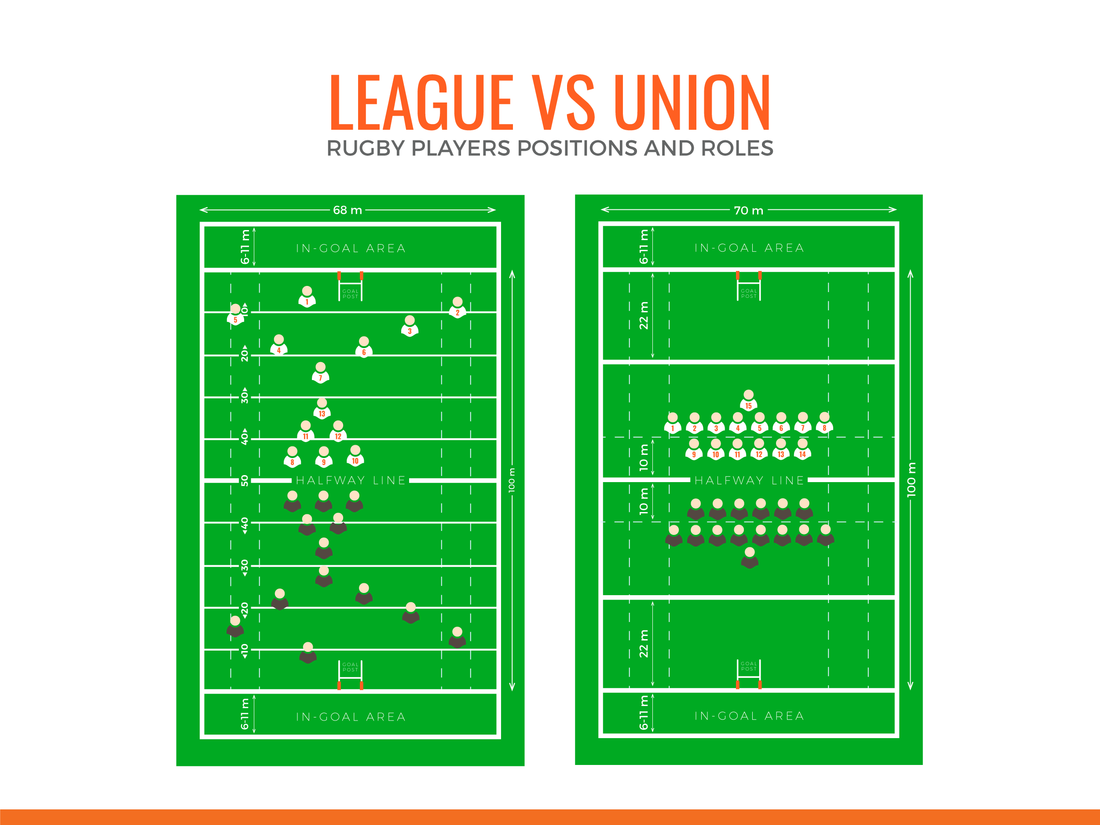Table Of Contents
Main Differences Between The Two Codes
Origins Of Rugby League And Rugby Union
Rugby Player Formations And Roles
Rules And Gameplay Explained
Major Rugby Leagues And Tournaments
Wrapping Up
Quick-Fire Answers To Common Questions
Key Takeaways:
Learn the key differences between rugby league and union—team size, scoring systems, tackle counts, scrums, field layout and popularity across Australia. This comparison helps sports clubs and supporters understand which code suits their team’s identity or event planning needs.
Think all rugby is the same? Think again!
In the world of Australian sports, Rugby Union and Rugby League stand out as fast-paced and physically demanding competitive games. While they have shared origins and similar rules, die-hard rugby fans will tell you just how dissimilar these two hard-hitting sports really are.
In this post, we're diving into the heart of these two thrilling sports, comparing and contrasting them to uncover what sets each apart.
From the number of players to the style of play and the different scoring rules - we’ve got it covered.
So, whether you're a rugby fan or just starting to learn about rugby rules, we’re glad you’re here. Keep reading below to find out the laws of Rugby League and Rugby Union and just how different these sports can be.
Main Differences Between the Two Codes
|
Aspect |
Rugby League |
Rugby Union |
|
Number of Players |
13 players |
15 players |
|
Tackles Rule |
Six-tackle rule |
Unlimited tackles |
|
Field Size |
Smaller field (approx. 100m x 68m) |
Larger field (approx. 100m x 70m) |
|
Scoring |
4 points for a try, 2 points for a goal |
5 points for a try, 2 or 3 points for a goal |
|
Set Pieces |
Scrum with fewer players, No line-outs |
Contested scrums and line-outs |
|
Play Style |
Faster-paced, more structured play |
More emphasis on possession, tactical depth |
|
Player Positions |
1 fullback, 2 wingers, 2 centres, 2 halves, 2 props, 1 hooker, 1 lock, 2 second-rowers |
1 fullback, 2 wingers, 2 front rowers, 1 hooker, 2 second rowers, 1 number 8, 1 scrum-half, 1 fly-half, 2 flankers, 2 centres |
|
Ball in Play |
Less frequent stoppages, more continuous play |
More stoppages due to rucks, mauls, and line-outs |
|
Play-The-Ball |
Used to restart play after a tackle |
Not used |
|
Rucks and Mauls |
Rucks and mauls have been replaced by “play-the-ball” |
Central to gameplay, contesting for possession |
|
Offside Rule |
10 metres from the play-the-ball |
Offside line varies, generally at the last feet of the ruck or maul |
|
Tackle Contest |
One-on-one contest for ball |
Multiple players can contest for the ball in rucks and mauls |
Origins of Rugby League and Rugby Union
Though sprung from the same roots, Rugby League and Rugby Union have evolved into two distinct games. It all started in the late 1800s in England. After many disputes regarding money and player compensation, multiple clubs came away from the original rugby game (Union) to create new leagues with updated rules. Some original rules stuck or were adapted, and some alternate rules were introduced.
Originally known as the “Northern Union”, the game we know as Rugby League today, became a professional sport in 1895.
Rugby League is known for its fast-paced, direct style. It features 13 players a side and is characterised by the 'six-tackle rule', which adds a layer of urgency and strategic planning to the game. On the other hand, Rugby Union, with its 15 players per team, emphasises endurance and tactical depth. It's a game where the contest for possession is often a strategic battle.
Field Layout Differences
Rugby League fields are generally smaller, about 100 metres long and 68 metres wide. This smaller size leads to a faster, more direct style of play. The in-goal area is larger too, so there's more room for those last-minute try-scoring dives fans go crazy for.
In contrast, Rugby Union fields are slightly larger, typically around 100 metres long and 70 metres wide. The in-goal area is narrower, changing how teams strategise for scoring. The larger field size in Union encourages a game focused more on territorial advantage and strategic kicking.

Having played on both types of fields, I've noticed how these dimensions impact the game. In League, the limited space means there's a constant, high-energy battle for every inch. It's about quick decisions and rapid plays. Whereas in Union, the extra space allows for more tactical battles and room to set up plays.
Rugby Player Formations and Roles
Understanding player formations and roles in each rugby code isn’t difficult. In fact, you’ll appreciate the differences in both once you understand how they work.
Rugby League

In Rugby League, the team consists of 13 players:
- A fullback
- Two wingers
- Two centres
- Two halves (stand-off half and scrum-half)
- Three forwards of which one is the hooker
- A hooker
- Two second-rowers
Numbers 1 through 7, the fullback, wingers, centres, and halves are considered backs. Numbers 8 through 13, the props, the hooker, second row and the lock are all considered forwards.
The game of Rugby League demands versatility, as players often cover multiple roles as part of the tactical gameplay and to cover injuries. The six-tackle rule shapes the gameplay. This means every position needs to be able to attack and defend. All players must have some speed and agility, though it is mostly expected from the backs and wingers. Brute strength comes from the forwards.
The forwards role is to carry the ball as far as they can across the field, through tackles and defensive walls. The fullback and the backs have the crucial job of making breakaway plays and quick counterattacks. The halves run the plays, finding space in the defensive side.
Rugby Union

Rugby Union, with 15 players, has a more specialised structure. The team is divided into eight forwards (two props, a hooker, two locks, two flankers, and a number eight) and seven backs (a scrum-half, a fly-half, two centres, two wingers, and a fullback).
Each role has specific responsibilities – forwards focus on possession and physical battles, while backs strategise to create and capitalise on scoring opportunities.

Rules and Gameplay Explained
Rugby League is characterised by its 'six-tackle' rule, where teams have six plays or 'tackles' to score or advance the ball as far as possible. Once the six tackles are up, the ball is handed over to the opposing team. This rule makes League a fast-paced, high-energy game where possession and territory gain are crucial.
Rugby Union's rules allow for more contesting and possession battles. There are no limits on the number of tackles, making the gameplay more about strategic advancement and control.
The ruck and maul are integral parts of Union, where teams contest intensely for the ball. The line-out, another unique feature of Union, brings a tactical edge to the game, especially after the ball goes out of play.
Each set of rules creates a different rhythm and style of play, and as a fan, I've found both to be equally exciting. Whether it's the strategic depth of Union or the fast-paced action of League, the variety in gameplay keeps the excitement levels high for players and spectators alike.
Major Rugby Leagues and Tournaments
Rugby League and Union both have tournaments that showcase the best players, teams and coaches in each code.
Rugby League Tournaments
Rugby League is played throughout the world in over 70 nations. It’s the national sport of the Cook Islands and Papua New Guinea, and is hugely popular in countries like New Zealand, Australia and Fiji.
The National Rugby League (NRL) in Australia and New Zealand are footy-fan favourites with sell-out games throughout the year. Then there's the Super League, primarily in England, known for its fierce competition and passionate fans. The Rugby League World Cup is another major event, drawing teams from around the globe to compete for the coveted title.
The most well-known and anticipated tournament in Australia is the State of Origin. Held between Sydney and QLD every year, the best players from QLD and NSW based teams go head-to-head in three epic matches. The trophy goes to the team who wins at least two of the three matches. State of Origin is statistically harder and faster than all other NRL games throughout the year. The competition is fierce and to be selected to play in State of Origin is a huge honour.
Rugby Union Tournaments
Rugby Union has its own set of renowned competitions. The Six Nations Championship in Europe is a spectacle of rugby prowess and national pride. Down South, the Rugby Championship features powerhouses like New Zealand, Australia, South Africa, and Argentina. And of course, the Rugby Union World Cup is a global event that brings together the best teams in a battle for ultimate glory.
I've had the chance to attend a few Six Nations matches, and the atmosphere is electrifying. The blend of sportsmanship and national pride creates an experience that goes beyond the game. Watching the All Blacks perform the Haka in the Rugby Championship is another unforgettable moment that reminds us all of the rich culture and tradition in Rugby Union.
Wrapping Up
From field dynamics to game-play strategy, Rugby League and Rugby Union each have unique qualities that extend even to the athlete's uniform. We've seen how these two codes, with their distinct rules and cultures, shape the experience of rugby.
Hopefully, after reading through the differences of each of these sports, you can appreciate how they differ and what each one brings to the sporting world. So, now that you know the main differences between Rugby League and Union, which one are you signing up for!?
Either way, if you’re looking for Rugby League or Rugby Union uniforms for your club, Cheeta Teamwear has it covered. Get in touch or browse through our rugby uniforms catalogue and let’s get to work on your rugby inspired designs today!
Quick-Fire Answers to Common Questions
Is Rugby League faster than Union?
Generally, yes. Rugby League's six-tackle rule makes for a quicker, more structured game.
Which is more popular worldwide, League or Union?
Rugby Union is played in over 100 countries while League is played in over 70. So in terms of viewership, Union is more popular.
Can a Rugby League player easily switch to Union and vice versa?
While it's possible, the different rules and play styles mean it can be quite a challenge. Rugby players like Israel Folau, Sonny Bill Williams and Stephen Myler successfully switched between Union and League on multiple occasions.
Which code is older, League or Union?
According to legend, Rugby Union is older, having been invented in the early 1800s. The split that created Rugby League occurred in 1895.
Are the balls different in League and Union?
They're similar, but the League ball is slightly smaller and more pointed.
Do you have scrums in Rugby League?
Yes, but they are less contested than in Union. The scrums in League are more about restarting play and are not as physically intensive.
Why are there two types of rugby?
The original rugby, (Union) was not a paid sport. The RFU didn’t believe in paying players and said that if men couldn’t afford to play, then they shouldn’t play. Many clubs wanted their players to spend more time training and on the field to give their teams an advantage. For this, they wanted to pay players for their time, dedication and commitment. After ongoing disputes, many of the clubs in the north of England decided to leave the RFU (Rugby Football Union) and start a new league.
Is Rugby League and NRL the same thing?
Not exactly. NRL (National Rugby League) is a major Rugby League competition in Australia and New Zealand. It's just one of the many leagues that play the Rugby League code.



